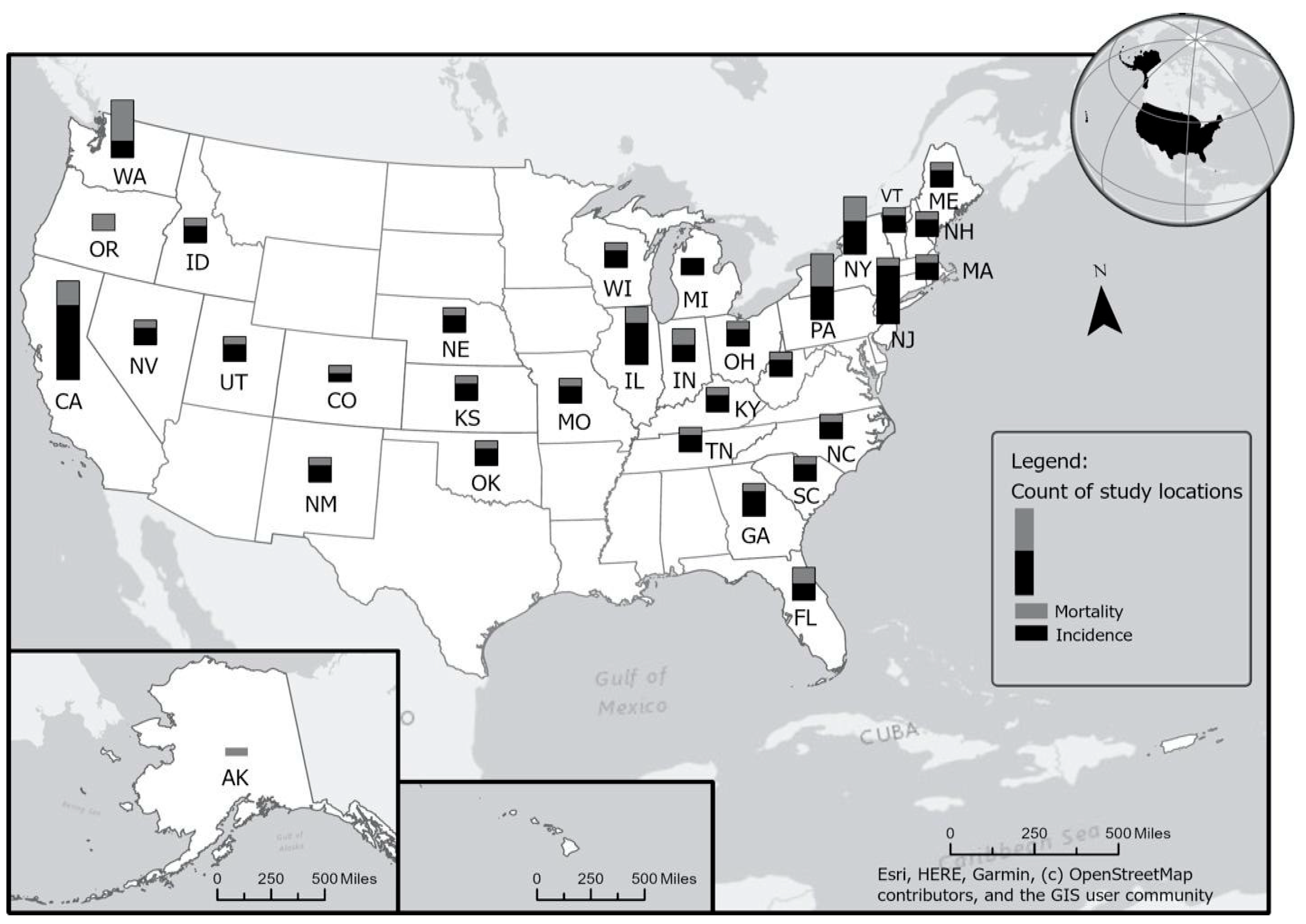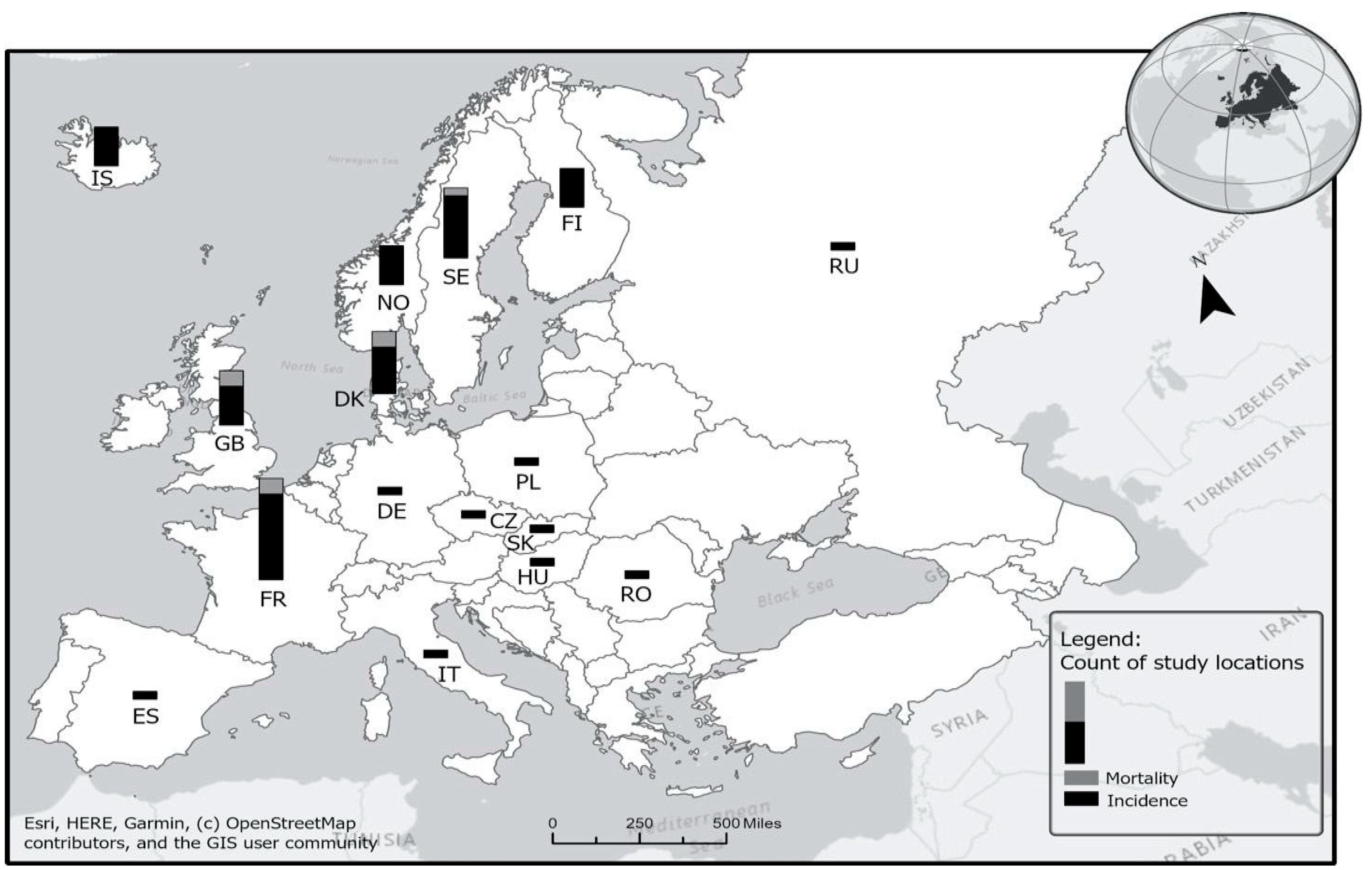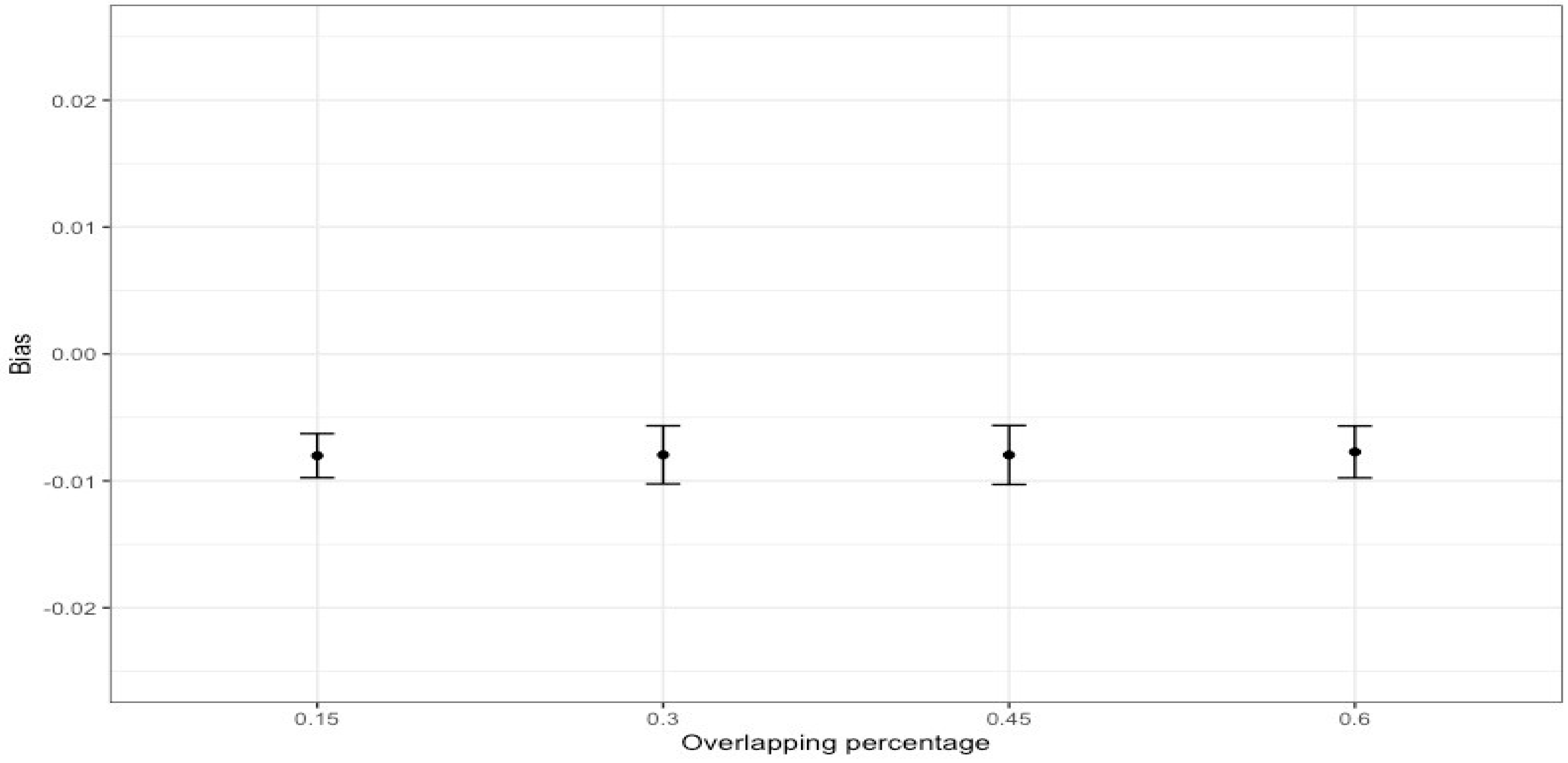Methodological and Practical Challenges in Synthesizing Occupational Cancer Studies
Abstract
:1. Introduction
2. Methodological and Practical Challenges in Synthesizing Study Findings from Occupational Cancer Studies
2.1. Comparability of Effect Size Measures Due to Variation in Research Methodology
2.2. Dependency Issues in Effect Sizes Arising from Data Overlapping in Time and Regions
2.3. Violation of Normality Assumption for Synthesizing Effect Size Measures
2.4. Inconsistencies in Cancer Diagnoses over Time
3. Discussion
4. Conclusions
Supplementary Materials
Author Contributions
Funding
Institutional Review Board Statement
Informed Consent Statement
Data Availability Statement
Acknowledgments
Conflicts of Interest
Abbreviations
| US | United States |
| IARC | International Agency for Research on Cancer |
| RR | Relative Risk |
| HR | Hazard Ratio |
| SIR | Standardized Incidence Ratio |
| SMR | Standardized Mortality Ratio |
| PMR | Proportional Mortality Ratio |
| OR | Odds Ratio |
| BMI | Body Mass Index |
| CI | 95% Confidence Interval |
| ICD | International Classification of Diseases |
| ICD-O | International Classification of Diseases for Oncology |
References
- National Cancer Institute. Cancer Stat Facts: Common Cancer Sites. Available online: https://seer.cancer.gov/statfacts/html/common.html (accessed on 2 June 2024).
- Heron, M. Deaths: Leading Causes for 2017. In National Center for Health Statistics; National Center for Health Statistics: Hyattsville, MD, USA, 2019; p. 68. [Google Scholar]
- Lortet-Tieulent, J.; Georges, D.; Bray, F.; Vaccarella, S. Profiling global cancer incidence and mortality by socioeconomic development. Int. J. Cancer 2020, 147, 3029–3036. [Google Scholar] [CrossRef]
- Global Burden of Disease Occupational Risk Factors Collaborators. Global and regional burden of disease and injury in 2016 arising from occupational exposures: A systematic analysis for the Global Burden of Disease Study 2016. Occup. Environ. Med. 2020, 77, 133–141. [Google Scholar] [CrossRef]
- Pukkala, E.; Martinsen, J.I.; Lynge, E.; Gunnarsdottir, H.K.; Sparén, P.; Tryggvadottir, L.; Weiderpass, E.; Kjaerheim, K. Occupation and cancer—follow-up of 15 million people in five Nordic countries. Acta Oncol 2009, 48, 646–790. [Google Scholar] [CrossRef] [PubMed]
- Rushton, L.; Bagga, S.; Bevan, R.; Brown, T.P.; Cherrie, J.W.; Holmes, P.; Fortunato, L.; Slack, R.; Van Tongeren, M.; Young, C.; et al. Occupation and cancer in Britain. Br. J. Cancer 2010, 102, 1428–1437. [Google Scholar] [CrossRef]
- Zaitsu, M.; Kaneko, R.; Takeuchi, T.; Sato, Y.; Kobayashi, Y.; Kawachi, I. Occupational class and male cancer incidence: Nationwide, multicenter, hospital-based case-control study in Japan. Cancer Med. 2019, 8, 795–813. [Google Scholar] [CrossRef]
- Kerr, J.; Anderson, C.; Lippman, S.M. Physical activity, sedentary behaviour, diet, and cancer: An update and emerging new evidence. Lancet Oncol. 2017, 18, e457–e471. [Google Scholar] [CrossRef] [PubMed]
- Modenese, A.; Korpinen, L.; Gobba, F. Solar Radiation Exposure and Outdoor Work: An Underestimated Occupational Risk. Int. J. Env. Res. Public Health 2018, 15, 2063. [Google Scholar] [CrossRef]
- Baan, R.; Grosse, Y.; Straif, K.; Secretan, B.; El Ghissassi, F.; Bouvard, V.; Benbrahim-Tallaa, L.; Guha, N.; Freeman, C.; Galichet, L.; et al. A review of human carcinogens—Part F: Chemical agents and related occupations. Lancet Oncol. 2009, 10, 1143–1144. [Google Scholar] [CrossRef] [PubMed]
- El-Serag, H.B. Epidemiology of viral hepatitis and hepatocellular carcinoma. Gastroenterology 2012, 142, 1264–1273.e1261. [Google Scholar] [CrossRef]
- Nelson, D.I.; Concha-Barrientos, M.; Driscoll, T.; Steenland, K.; Fingerhut, M.; Punnett, L.; Prüss-Ustün, A.; Leigh, J.; Corvalan, C. The global burden of selected occupational diseases and injury risks: Methodology and summary. Am. J. Ind. Med. 2005, 48, 400–418. [Google Scholar] [CrossRef]
- Takala, J. Eliminating occupational cancer. Ind. Health 2015, 53, 307–309. [Google Scholar] [CrossRef]
- IARC Working Group on the Evaluation of Carcinogenic Risks to Humans. Painting, Firefighting, and Shiftwork; IARC Monographs on the Evaluation of Carcinogenic Risks to Humans, No. 98; International Agency for Research on Cancer: Lyon, France, 2010. Available online: https://www.ncbi.nlm.nih.gov/books/NBK326814/ (accessed on 1 June 2024).
- IARC. Night Shift Work. IARC Monogr. Identif. Carcinog. Hazards Hum. 2020, 124, 1–371. [Google Scholar]
- Lee, D.J.; Ahn, S.; McClure, L.A.; Caban-Martinez, A.J.; Kobetz, E.N.; Ukani, H.; Boga, D.J.; Hernandez, D.; Pinheiro, P.S. Cancer risk and mortality among firefighters: A meta-analytic review. Front. Oncol. 2023, 13, 1130754. [Google Scholar] [CrossRef] [PubMed]
- Daniels, R.D.; Kubale, T.L.; Yiin, J.H.; Dahm, M.M.; Hales, T.R.; Baris, D.; Zahm, S.H.; Beaumont, J.J.; Waters, K.M.; Pinkerton, L.E. Mortality and cancer incidence in a pooled cohort of US firefighters from San Francisco, Chicago and Philadelphia (1950–2009). Occup. Environ. Med. 2014, 71, 388–397. [Google Scholar] [CrossRef]
- Baris, D.; Garrity, T.J.; Telles, J.L.; Heineman, E.F.; Olshan, A.; Zahm, S.H. Cohort mortality study of Philadelphia firefighters. Am. J. Ind. Med. 2001, 39, 463–476. [Google Scholar] [CrossRef]
- Coggon, D.; Harris, E.C.; Brown, T.; Rice, S.; Palmer, K.T. Occupation and mortality related to alcohol, drugs and sexual habits. Occup. Med. 2010, 60, 348–353. [Google Scholar] [CrossRef] [PubMed]
- Musk, A.W.; Monson, R.R.; Peters, J.M.; Peters, R.K. Mortality among Boston firefighters, 1915—1975. Br. J. Ind. Med. 1978, 35, 104–108. [Google Scholar] [CrossRef]
- Demers, P.A.; Checkoway, H.; Vaughan, T.L.; Weiss, N.S.; Heyer, N.J.; Rosenstock, L. Cancer incidence among firefighters in Seattle and Tacoma, Washington (United States). Cancer Causes Control. 1994, 5, 129–135. [Google Scholar] [CrossRef] [PubMed]
- Feuer, E.; Rosenman, K. Mortality in police and firefighters in New Jersey. Am. J. Ind. Med. 1986, 9, 517–527. [Google Scholar] [CrossRef]
- Kang, D.; Davis, L.K.; Hunt, P.; Kriebel, D. Cancer incidence among male Massachusetts firefighters, 1987–2003. Am. J. Ind. Med. 2008, 51, 329–335. [Google Scholar] [CrossRef]
- Goodman, K.J.; Bible, M.L.; London, S.; Mack, T.M. Proportional melanoma incidence and occupation among White males in Los Angeles County (California, United States). Cancer Causes Control. 1995, 6, 451–459. [Google Scholar] [CrossRef] [PubMed]
- Petersen, K.K.U.; Pedersen, J.E.; Bonde, J.P.; Ebbehoej, N.E.; Hansen, J. Long-term follow-up for cancer incidence in a cohort of Danish firefighters. Occup. Environ. Med. 2018, 75, 263–269. [Google Scholar] [CrossRef]
- Smith, A.H.; Pearce, N.E.; Callas, P.W. Cancer Case-Control Studies with Other Cancers as Controls. Int. J. Epidemiol. 1988, 17, 298–306. [Google Scholar] [CrossRef] [PubMed]
- Moore, K.J.; Caban-Martinez, A.J.; Kirsner, R.S.; Schaefer-Solle, N.; Lee, D.J.; Koru-Sengul, T.; Kobetz, E.N. Firefighter Skin Cancer and Sun Protection Practices: Evidence From the Florida Firefighter Cancer Initiative. JAMA Derm. 2018, 154, 219–221. [Google Scholar] [CrossRef] [PubMed]
- Karami, S.; Colt, J.S.; Schwartz, K.; Davis, F.G.; Ruterbusch, J.J.; Munuo, S.S.; Wacholder, S.; Stewart, P.A.; Graubard, B.I.; Rothman, N.; et al. A case–control study of occupation/industry and renal cell carcinoma risk. BMC Cancer 2012, 12, 344. [Google Scholar] [CrossRef]
- Bates, M.N.; Lane, L. Testicular cancer in fire fighters: A cluster investigation. N. Z. Med. J. 1995, 108, 334–337. [Google Scholar]
- Polanin, J.R.; Snilstveit, B. Converting between effect sizes. Campbell Syst. Rev. 2016, 12, 1–13. [Google Scholar] [CrossRef]
- Bates, M.N. Registry-based case–control study of cancer in California firefighters. Am. J. Ind. Med. 2007, 50, 339–344. [Google Scholar] [CrossRef] [PubMed]
- Tsai, R.J.; Luckhaupt, S.E.; Schumacher, P.; Cress, R.D.; Deapen, D.M.; Calvert, G.M. Risk of cancer among firefighters in California, 1988–2007. Am. J. Ind. Med. 2015, 58, 715–729. [Google Scholar] [CrossRef]
- Pukkala, E.; Martinsen, J.I.; Weiderpass, E.; Kjaerheim, K.; Lynge, E.; Tryggvadottir, L.; Sparén, P.; Demers, P.A. Cancer incidence among firefighters: 45 years of follow-up in five Nordic countries. Occup. Environ. Med. 2014, 71, 398–404. [Google Scholar] [CrossRef]
- Pieper, D.; Waltering, A.; Holstiege, J.; Büchter, R.B. Quality ratings of reviews in overviews: A comparison of reviews with and without dual (co-)authorship. Syst. Rev. 2018, 7, 63. [Google Scholar] [CrossRef] [PubMed]
- Van den Noortgate, W.; Onghena, P. Multilevel Meta-Analysis: A Comparison with Traditional Meta-Analytical Procedures. Educ. Psychol. Meas. 2003, 63, 765–790. [Google Scholar] [CrossRef]
- Tanner-Smith, E.E.; Tipton, E. Robust variance estimation with dependent effect sizes: Practical considerations including a software tutorial in Stata and spss. Res. Synth. Methods 2014, 5, 13–30. [Google Scholar] [CrossRef] [PubMed]
- Johnson, B.T.; Huedo-Medina, T.B. Meta-Analytic Statistical Inferences for Continuous Measure Outcomes as a Function of Effect Size Metric and Other Assumptions; Agency for Healthcare Research and Quality (US): Rockville, MD, USA, 2013. [Google Scholar]
- Harwell, M. An empirical study of Hedge’s homogeneity test. Psychol. Methods 1997, 2, 219–231. [Google Scholar] [CrossRef]
- Huedo-Medina, T.B.; Sánchez-Meca, J.; Marín-Martínez, F.; Botella, J. Assessing heterogeneity in meta-analysis: Q statistic or I2 index? Psychol. Methods 2006, 11, 193–206. [Google Scholar] [CrossRef] [PubMed]
- Sun, R.W.; Cheung, S.F. The influence of nonnormality from primary studies on the standardized mean difference in meta-analysis. Behav. Res. Methods 2020, 52, 1552–1567. [Google Scholar] [CrossRef] [PubMed]
- Higgins, J.P.T.; Lane, P.W.; Anagnostelis, B.; Anzures-Cabrera, J.; Baker, N.F.; Cappelleri, J.C.; Haughie, S.; Hollis, S.; Lewis, S.C.; Moneuse, P.; et al. A tool to assess the quality of a meta-analysis. Res. Synth. Methods 2013, 4, 351–366. [Google Scholar] [CrossRef] [PubMed]
- Nakagawa, S.; Noble, D.W.A.; Senior, A.M.; Lagisz, M. Meta-evaluation of meta-analysis: Ten appraisal questions for biologists. BMC Biol. 2017, 15, 18. [Google Scholar] [CrossRef] [PubMed]
- Oxman, A.D.; Guyatt, G.H. Guidelines for reading literature reviews. Can. Med. Assoc. J. 1988, 138, 697–703. [Google Scholar]
- Shea, B.J.; Grimshaw, J.M.; Wells, G.A.; Boers, M.; Andersson, N.; Hamel, C.; Porter, A.C.; Tugwell, P.; Moher, D.; Bouter, L.M. Development of AMSTAR: A measurement tool to assess the methodological quality of systematic reviews. BMC Med. Res. Methodol. 2007, 7, 10. [Google Scholar] [CrossRef]





Disclaimer/Publisher’s Note: The statements, opinions and data contained in all publications are solely those of the individual author(s) and contributor(s) and not of MDPI and/or the editor(s). MDPI and/or the editor(s) disclaim responsibility for any injury to people or property resulting from any ideas, methods, instructions or products referred to in the content. |
© 2024 by the authors. Licensee MDPI, Basel, Switzerland. This article is an open access article distributed under the terms and conditions of the Creative Commons Attribution (CC BY) license (https://creativecommons.org/licenses/by/4.0/).
Share and Cite
Ahn, S.; McClure, L.A.; Pinheiro, P.S.; Hernandez, D.; Boga, D.J.; Ukani, H.; Chavez, J.V.; Quintela Fernandez, J.A.; Caban-Martinez, A.J.; Kobetz, E.; et al. Methodological and Practical Challenges in Synthesizing Occupational Cancer Studies. Int. J. Environ. Res. Public Health 2024, 21, 742. https://doi.org/10.3390/ijerph21060742
Ahn S, McClure LA, Pinheiro PS, Hernandez D, Boga DJ, Ukani H, Chavez JV, Quintela Fernandez JA, Caban-Martinez AJ, Kobetz E, et al. Methodological and Practical Challenges in Synthesizing Occupational Cancer Studies. International Journal of Environmental Research and Public Health. 2024; 21(6):742. https://doi.org/10.3390/ijerph21060742
Chicago/Turabian StyleAhn, Soyeon, Laura A. McClure, Paulo S. Pinheiro, Diana Hernandez, Devina J. Boga, Henna Ukani, Jennifer V. Chavez, Jorge A. Quintela Fernandez, Alberto J. Caban-Martinez, Erin Kobetz, and et al. 2024. "Methodological and Practical Challenges in Synthesizing Occupational Cancer Studies" International Journal of Environmental Research and Public Health 21, no. 6: 742. https://doi.org/10.3390/ijerph21060742




